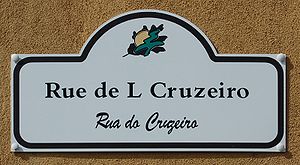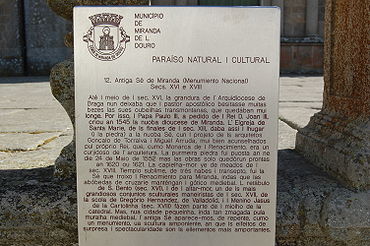- Mirandese language
-
Mirandese mirandés Spoken in  Portugal
PortugalRegion Northeastern Portugal (municipalities of Miranda do Douro, Vimioso and Mogadouro) Native speakers 10,000-15,000[1] (date missing) Language family Indo-European- Italic
- Romance
- Western
- Gallo-Iberian
- Ibero-Romance
- West Iberian
- Astur-Leonese
- Mirandese
- Astur-Leonese
- West Iberian
- Ibero-Romance
- Gallo-Iberian
- Western
- Romance
Official status Official language in Co-official recognition. Special protection status in Miranda do Douro, Portugal Regulated by Anstituto de la Lhéngua Mirandesa Language codes ISO 639-2 mwl ISO 639-3 mwl Linguasphere 51-AAA-cb This page contains IPA phonetic symbols in Unicode. Without proper rendering support, you may see question marks, boxes, or other symbols instead of Unicode characters.  Street sign, at Genísio village, with the street name in Mirandese and in Portuguese
Street sign, at Genísio village, with the street name in Mirandese and in Portuguese
The Mirandese language (autonym: mirandés or lhéngua mirandesa; Portuguese: mirandês or língua mirandesa) is a Romance language belonging to the Astur-Leonese linguistic group, sparsely spoken in a small area of northeastern Portugal, in the municipalities of Miranda do Douro, Mogadouro and Vimioso. The Portuguese Parliament granted it co-official recognition (along with the Portuguese language) for local matters on 17 September 1998 with the law 7/99 of 29 January 1999.
Mirandese has a distinct phonology, morphology and syntax, and has been distinct at least since the formation of Portugal in the 12th century.[citation needed] It has its roots in the spoken Latin of the north of the Iberian Peninsula (Portuguese developed in the northwest). It is a descendant of the ancient Astur-Leonese language of northern Iberia, the last remnant of the ancient language of the Kingdom of León, and closely related to the modern Astur-Leonese languages in Spain. However, these amalgamations in the Spanish territory did not affect Mirandese, which preserves distinct linguistic differences in relation to both Portuguese and Spanish. It shares a great deal of lexicon with regional Portuguese dialects.
Contents
Speakers
In the 19th century, José Leite de Vasconcelos, described it as "the language of the farms, of work, home, and love between the Mirandese". Since 1986/1987 the language has been taught to students between the age of 10 and 11, and the language is recovering.
Today Mirandese retains fewer than 5,000 speakers (but the number can be up to 15,000 if counting second language speakers) in the villages of the Municipality of Miranda do Douro and in some eastern villages (i.e. Vilar Seco & Angueira; in Caçarelhos, it is considered recently extinct) of the Municipality of Vimioso, and some linguistic influence can be observed at other villages of the municipality of Vimioso and the municipalities of Mogadouro, Macedo de Cavaleiros and Bragança.
Variants
Three variants of the Mirandese language exist: Border Mirandese (Mirandés Raiano), Central Mirandese (Mirandés Central) and Sendinese (Sendinés). Most speakers of Mirandese also speak Portuguese; some of these speak Spanish as well.
The main differences between Mirandese in Portugal and the Astur-Leonese languages in Spain are caused by the dominant languages in each region. Mirandese has been influenced phonetically and in lexicon by Portuguese and the Astur-Leonese languages in Spain by Spanish (Castilian). All have distinctive orthography that phonetically reflects the respective main national languages. Another difference is that Mirandese and Leonese remain very conservative, while Asturian has undergone a greater amount of change.[citation needed]
Features
Phonology
A number of historical traits link Mirandese to Portuguese rather than Spanish:
- Mirandese keeps the initial /f/ from Latin, like Portuguese, Catalan, French and most Occitan dialects (vs. Spanish /h/ > nothing).
- The Latin initial consonant clusters /pl/, /kl/, /fl/ evolve into ⟨ch⟩ (vs. Spanish ⟨ll⟩).
- Proto-Romance medial clusters -ly- and -cl- became medieval /ʎ/ (vs. medieval Spanish /dʒ/, modern /x/).
- The cluster /-mb-/ is kept (vs. Spanish /mb/ > /m/).
- Proto-Romance -mn- becomes /m/ (vs. Spanish /mbr/): lūm'nem > lume (Spanish lumbre).
- Falling diphthongs /ei/, /ou/ preserved (vs. Spanish /e/, /o/).
- Final -o becomes /u/.
- Voiced sibilants are still maintained (whereas in Spanish they merged with the voiceless sibilants).
Traits different from Portuguese:
- Intervocalic /l/, /n/ not dropped.
- Western Romance /ɛ/,/ɔ/ diphthongize to ⟨ie⟩,⟨ue⟩. This happens even before palatals (as in Aragonese), but before nasals.
- Like in Catalan, /l/ is palatalized word-initially.
- Mirandese maintains distinct reflexes of all seven medieval Ibero-Romance sibilants: ⟨ch⟩ /tʃ/, ⟨x⟩ /ʃ/, ⟨g/j⟩ /ʒ/, ⟨c/ç⟩ /s/, ⟨z⟩ /z/, ⟨s/-ss-⟩ /ṣ/, -⟨s-⟩ /ẓ/. /ṣ/ and /ẓ/ indicate apico-alveolar sibilants (as in modern Catalan and northern/central peninsular Spanish), while /s/ and /z/ are lamino-alveolar sibilants (as in modern Portuguese, French and English). Portuguese spelling still distinguishes all seven, and is identical to Mirandese spelling in this respect, but in pronunciation has reduced them to four: /s z ʃ ʒ/. Northern/central Peninsular Spanish has also reduced them to four, but in a quite different way: /tʃ θ ṣ x/. Andalusian Spanish and Latin American Spanish have further reduced them to three: /tʃ s h/.
Morphology
As in conservative Portuguese, Mirandese still uses the following synthetic tenses:
- Synthetic pluperfect in -ra.
- Future subjunctive in -r(e).
- Personal infinitive in -r(e). This has the same endings as the future subjunctive but differs in many cases because the personal infinitive always uses the infinitive stem while the future subjunctive uses the past-tense stem.
Sample text
The following is a sample text of the Mirandese language, written by Amadeu Ferreira, and published in the newspaper Público, on the 24th July 2007.
Mirandese: Portuguese: English: Muitas lhénguas ténen proua de ls sous pergaminos antigos, de la lhiteratura screbida hai cientos d'anhos i de scritores hai muito afamados, hoije bandeiras dessas lhénguas. Mas outras hai que nun puoden tener proua de nada desso, cumo ye l causo de la lhéngua mirandesa.
Muitas línguas têm orgulho dos seus pergaminhos antigos, da literatura escrita há centenas de anos e de escritores muito famosos, hoje bandeiras dessas línguas. Mas há outras que não podem ter orgulho de nada disso, como é o caso da língua mirandesa.
Many languages are proud of their ancient scrolls, of the literature written hundreds of years ago and of famous writers, today flags of those languages. But others can't be proud of that, as is the case of the Mirandese language.
Then a comparison of the previous text in three modern languages of the Astur-leones group:
Mirandese: Leonese: Asturian: Muitas lhénguas ténen proua de ls sous pergaminos antigos, de la lhiteratura screbida hai cientos d'anhos i de scritores hai muito afamados, hoije bandeiras dessas lhénguas. Mas outras hai que nun puoden tener proua de nada desso, cumo ye l causo de la lhéngua mirandesa.
Muitas llinguas tien arguyu de los sous pergaminos antiguos, de la lliteratura escrita van cientos d'annos y d'escritores bien famosos; guei bandeiras d'eisas llinguas. Peru hai outras que nun pueden tener arguyu de nada d'eisu, cumu ye'l casu de la llingua mirandesa.
Munches llingües tienen arguyu de los sos pergaminos antiguos, de la lliteratura escrita hai cientos d'años y d'escritores enforma famosos, güei banderes d'eses llingües. Pero hai otres que nun pueden tener arguyu de nada d'eso, como ye'l casu de la llingua mirandesa.
National attention
Mirandese, given its status as second official language in Portugal after Portuguese, has been the subject in recent years of some publicity and attention in other parts of Portugal. A monthly chronicle in Mirandese, by researcher and writer Amadeu Ferreira, appears in the daily Portuguese national newspaper Público. The first volume of the The Adventures of Asterix, named Asterix, L Goulés (Asterix the Gaul), was published in a Mirandese translation by Amadeu Ferreira in 2005, and sold throughout Portugal. Amadeu Ferreira also translated into Mirandese the epic poem by Camões, Os Lusíadas (Ls Lusíadas), under his pseudonym Francisco Niebro and published it in 2009.
See also
- Astur-Leonese Group
References
- ^ "Asturian". 10.gencat.net. http://www10.gencat.net/pres_casa_llengues/AppJava/frontend/llengues_detall.jsp?id=43&idioma=5. Retrieved 12 December 2010.
- Ferreira, Manuela Barros e Raposo, Domingos (coord) (1999), Convenção Ortográfica da Língua Mirandesa, Miranda do Douro / Lisbon, ed. Câmara Municipal de Miranda do Douro / Centro de Linguística da Universidade de Lisboa
External links
- Mirandese as an Endangered Language (PDF, in English)
- (Portuguese) Orthographic Convention for Mirandese Language (PDF)
- Mirandés na Net Lhéngua i Cultura Mirandesa (Mirandese Language & Culture)
- Excerpt of The Lusiads in Mirandese
- L Mirandés: Ũa Lhéngua Minoritaira an Pertual Mirandese: A minority language in Portugal (PDF, in Mirandese)
- (Portuguese) Piece of legislation which officially recognizes Mirandese as a language of Portugal
Romance languages Western and Italo-Dalmatian Western Gallo-Italic LigurianOthersGallo-Rhaetian Burgundian · Champenois · Franc-Comtois · French (Standard · African · Canadian · Old French · Middle French · Judaeo-French · French-based creoles) · Gallo · Lorrain · Norman · Picard · Poitevin · Saintongeais · WalloonRhaeto-RomanceOthersOccitano-
RomanceAuvergnat · Gascon (Aranese) · Languedocien · Limousin · Provençal (Niçard · Mentonasc) · Vivaro-Alpine · Old Provençal · Judaeo-ProvençalIbero-Romance Astur-LeonesePortuguese (European · Brazilian · African · Asian & Oceanian) · Galician (Eonavian) · Fala · Judaeo-Portuguese · Portuguese Calão · Portuguese-based creolesAfrican (Equatoguinean) · American · Asian · Peninsular · Old Spanish · Judaeo-Spanish · Spanish Caló · Spanish-based creolesPyreneanItalo-Dalmatian OthersEastern and Sardinian Eastern OthersSardinian —Italics indicate extinct languages; bold indicates languages with more than 5 million speakers; languages between parentheses are varieties of the language on their left.Categories:- Language articles with undated speaker data
- Languages of Portugal
- Endangered Romance languages
- Italic
Wikimedia Foundation. 2010.

